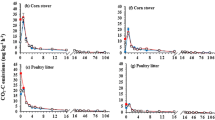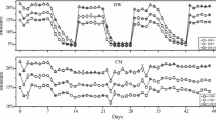Abstract
Purpose
Aglime application can promote carbon dioxide (CO2) emissions from acid soils. However, the controlling mechanisms are still poorly understood, particularly the role of fertiliser-ammonium oxidation. This study therefore assessed the effects of aglime on soil inorganic C (SIC)– and soil organic C (SOC)–derived CO2 emissions from acid soils amended with ammonium.
Materials and methods
Ammonium at three N rates [0% (A0), 0.005% (A1), and 0.2% (A2) w/w] and labelled aglime (Ca13CO3,13C 5.94% aa) at three rates [0% (L1), 0.067% (L1), and 0.392% (L2) w/w] were applied to two contrasting acid soils (Nariva series, Mollic Fluvaquents; and Piarco series, Typic Kanhaplaquults) and incubated in 1-l media bottles for 23 days. A calcareous soil (Princes Town series, Aquentic Eutrudepts, carbonate δ13C of − 4.79‰) was included as a control that only received ammonium at the three rates.
Results and discussion
The application of ammonium at the A2 rate significantly (p < 0.05) increased cumulative SIC-CO2 emissions by 15.8 and 27.1% in comparison to the A0 rate for the Nariva and Piarco soils, respectively, when they were limed at the L2 rate. The lower rate of ammonium (A1), however, had no effect on these emissions, which suggests that enough acidity may not have been generated at this rate to significantly enhance the release of SIC-CO2. Furthermore, no effect of ammonium rates was observed on SIC-CO2 emissions from the calcareous soil, which refutes the hypothesis that this amendment plays a greater role in regulating these emissions from calcareous soils compared with acid soils. Also, in contradiction to another hypothesis, the aglime-induced priming effect on SOC decomposition was more apparent in the low-C Piarco soil. This effect was also significantly (p < 0.05) greater at the L2 rate (above the lime requirement for Piarco), which demonstrates the negative impact that over-liming could have on the sequestration of C in this soil. Our results also showed that ammonium addition may also help to reduce the magnitude of the aglime-induced priming effect in the Piarco soil when it is not over-limed.
Conclusions
Overall, the findings of this study suggest that ammonium fertiliser broadcast at conventional rates may not serve as a significant regulator of SIC-CO2 emissions from highly to moderately acidic soils amended with aglime. Our findings also indicate a need to consider nitrogen management as an important factor regulating the effects of aglime on SOC-CO2 emissions.



Similar content being viewed by others
References
Adviento-Borbe M, Doran J, Drijber R, Dobermann A (2006) Soil electrical conductivity and water content affect nitrous oxide and carbon dioxide emissions in intensively managed soils. J Environ Qual 35:1999–2010
Ahmad W, Singh B, Dijkstra FA, Dalal R (2013) Inorganic and organic carbon dynamics in a limed acid soil are mediated by plants. Soil Biol Biochem 57:549–555
Ahmad W, Singh B, Dijkstra FA, Dalal RC, Geelan-Small P (2014) Temperature sensitivity and carbon release in an acidic soil amended with lime and mulch. Geoderma 214:168–176
Ahmad W, Singh B, Dalal RC, Dijkstra FA (2015) Carbon dynamics from carbonate dissolution in Australian agricultural soils. Soil Res 53:144–153
Akhtar M, Hussain F, Ashraf MY, Qureshi TM, Akhter J, Awan AR (2012) Influence of salinity on nitrogen transformations in soil. Communin Soil Sci Plan 43:1674–1683
Aye NS, Butterly CR, Sale PW, Tang C (2017) Residue addition and liming history interactively enhance mineralization of native organic carbon in acid soils. Biol Fertil Soils 53:61–75
Aye NS, Butterly CR, Sale PW, Tang C (2018) Interactive effects of initial pH and nitrogen status on soil organic carbon priming by glucose and lignocellulose. Soil Biol Biochem 123:33–44
Bertrand I, Delfosse O, Mary B (2007) Carbon and nitrogen mineralization in acidic, limed and calcareous agricultural soils: apparent and actual effects. Soil Biol Biochem 39:276–288
Biasi C, Lind SE, Pekkarinen NM, Huttunen JT, Shurpali NJ, Hyvönen NP, Repo ME, Martikainen PJ (2008) Direct experimental evidence for the contribution of lime to CO2 release from managed peat soil. Soil Biol Biochem 40:2660–2669
Bramble DSE, Gouveia GA, Ramnarine R (2019) Organic residues and ammonium effects on CO2 emissions and soil quality indicators in limed acid tropical soils. Soil Syst 3:16
Castro GSA, Crusciol CAC (2015) Effects of surface application of dolomitic limestone and calcium-magnesium silicate on soybean and maize in rotation with green manure in a tropical region. Bragantia 74:311–321
Chen R, Senbayram M, Blagodatsky S, Myachina O, Dittert K, Lin X, Blagodatskaya E, Kuzyakov Y (2014) Soil C and N availability determine the priming effect: microbial N mining and stoichiometric decomposition theories. Glob Chang Biol 20:2356–2367
Chen Z, Xu Y, Fan J, Yu H, Ding W (2017) Soil autotrophic and heterotrophic respiration in response to different N fertilization and environmental conditions from a cropland in Northeast China. Soil Biol Biochem 110:103–115
Chen Z, Xu Y, He Y, Zhou X, Fan J, Yu H, Ding W (2018) Nitrogen fertilization stimulated soil heterotrophic but not autotrophic respiration in cropland soils: a greater role of organic over inorganic fertilizer. Soil Biol Biochem 116:253–264
Chou L, Garrels RM, Wollast R (1989) Comparative study of the kinetics and mechanisms of dissolution of carbonate minerals. Chem Geol 78:269–282
Cusack DF, Torn MS, McDowell WH, Silver WL (2010) The response of heterotrophic activity and carbon cycling to nitrogen additions and warming in two tropical soils. Glob Chang Biol 16(9):2555–2572
da Costa CHM, Crusciol CAC, Ferrari Neto J, Castro GSA (2016) Residual effects of superficial liming on tropical soil under no-tillage system. Pesqui Agropecu Bras 51:1633–1642
Dumale WA Jr, Miyazaki T, Hirai K, Nishimura T (2011) SOC turnover and lime-CO2 evolution during liming of an acid andisol and ultisol. Open J Soil Sci 1:49–53
Dungait JA, Hopkins DW, Gregory AS, Whitmore AP (2012) Soil organic matter turnover is governed by accessibility not recalcitrance. Glob Chang Biol 18:1781–1796
Francis R, Wuddivira MN, Darsan J, Wilson M (2019) Soil slaking sensitivity as influenced by soil properties in alluvial and residual humid tropical soils. J Soils Sediments 19:1937–1947
Gleeson DB, Müller C, Banerjee S, Ma W, Siciliano SD, Murphy DV (2010) Response of ammonia oxidizing archaea and bacteria to changing water filled pore space. Soil Biol Biochem 42:1888–1891
Grandy AS, Salam DS, Wickings K, McDaniel MD, Culman SW, Snapp SS (2013) Soil respiration and litter decomposition responses to nitrogen fertilization rate in no-till corn systems. Agric Ecosyst Environ 179:35–40
Grover S, Butterly C, Wang X, Tang C (2017) The short-term effects of liming on organic carbon mineralisation in two acidic soils as affected by different rates and application depths of lime. Biol Fertil Soils 53:431–443
Hamid, YSA (2009) Dissolution kinetics of carbonates in soil, Phd thesis. Szent István University, Gödöllő, Hungary
Hamilton SK, Kurzman AL, Arango C, Jin L, Robertson GP (2007) Evidence for carbon sequestration by agricultural liming. Glob Biogeochem Cycles 21:1–13
Harris D, Horwáth WR, Van Kessel C (2001) Acid fumigation of soils to remove carbonates prior to total organic carbon or carbon-13 isotopic analysis. Soil Sci Soc Am J 65:1853–1856
Hendershot WH, Lalande H, Duquette M (2008) Soil reaction and exchanageble acidity. In: Carter MR, Gregorich EG (eds) Soil sampling and methods of analysis, 2nd edn. CRC Pres, Boca Raton, FL, pp 173–178
Keller JK, Bridgham SD, Chapin CT, Iversen CM (2005) Limited effects of six years of fertilization on carbon mineralization dynamics in a Minnesota fen. Soil Biol Biochem 37:1197–1204
Lardner T, George S, Tibbett M (2015) Interacting controls on innate sources of CO2 efflux from a calcareous arid zone soil under experimental acidification and wetting. J Arid Environ 122:117–123
Li L-J, Zhu-Barker X, Ye R, Doane TA, Horwath WR (2018) Soil microbial biomass size and soil carbon influence the priming effect from carbon inputs depending on nitrogen availability. Soil Biol Biochem 119:41–49
Manangi M, Coon C (2007) The effect of calcium carbonate particle size and solubility on the utilization of phosphorus from phytase for broilers. Int J Poult Sci 6:85–90
Miao S, Ye R, Qiao Y, Zhu-Barker X, Doane TA, Horwath WR (2017) The solubility of carbon inputs affects the priming of soil organic matter. Plant Soil 410:129–138
Pokrovsky OS, Schott J (1999) Processes at the magnesium-bearing carbonates/solution interface. II. Kinetics and mechanism of magnesite dissolution. Geochim Cosmochim Acta 63:881–897
Ramirez KS, Craine JM, Fierer N (2010) Nitrogen fertilization inhibits soil microbial respiration regardless of the form of nitrogen applied. Soil Biol Biochem 42(12):2336–2338
Ramnarine R, Wagner-Riddle C, Dunfield K, Voroney R (2012) Contributions of carbonates to soil CO2 emissions. Can J Soil Sci 92:599–607
Rhoades J (1982) Cation exchange capacity. In: Page AL, Miller RH, Keeney DR (eds) Methods of soil analysis part 2 chemical and microbiological properties. Soil Science Society of America, Inc, Madison, WI, pp 146–157
Rousk J, Brookes PC, Bååth E (2009) Contrasting soil pH effects on fungal and bacterial growth suggest functional redundancy in carbon mineralization. Appl Environ Microbiol 75:1589–1596
Sanderman J (2012) Can management induced changes in the carbonate system drive soil carbon sequestration? A review with particular focus on Australia. Agric Ecosyst Environ 155:70–77
Schindlbacher A, Borken W, Djukic I, Brandstätter C, Spötl C, Wanek W (2015) Contribution of carbonate weathering to the CO2 efflux from temperate forest soils. Biogeochemistry 124:273–290
Shahbaz M, Kumar A, Kuzyakov Y, Börjesson G, Blagodatskaya B (2018) Priming effects induced by glucose and decaying plant residues on som decomposition: a three-source 13C/14C partitioning study. Soil Biol Biochem 121:138–146
Tamir G, Shenker M, Heller H, Bloom PR, Fine P, Bar-Tal A (2013) Organic N mineralization and transformations in soils treated with animal waste in relation to carbonate dissolution and precipitation. Geoderma 209:50–56
Tilman D, Fargione J, Wolff B, D'Antonio C, Dobson A, Howarth R, Schindler D, Schlesinger WH, Simberloff D, Swackhamer D (2001) Forecasting agriculturally driven global environmental change. Science 292:281–284
Wachendorf C (2015) Effects of liming and mineral N on initial decomposition of soil organic matter and post harvest root residues of poplar. Geoderma 259:243–250
Wang L, Han Z, Zhang X (2010) Effect of soil pH on CO2 emission from long-term fertilized black soils in Northeastern China Sci Res, pp 58-61
West TO, McBride AC (2005) The contribution of agricultural lime to carbon dioxide emissions in the United States: dissolution, transport, and net emissions. Agric Ecosyst Environ 108:145–154
Wuddivira MN, Stone RJ, Ekwue EI (2013) Influence of cohesive and disruptive forces on strength and erodibility of tropical soils. Soil Tillage Res 133:40–48
Zhou Z, Wang C, Zheng L, Jiang L, Luo Y (2017) Patterns and mechanisms of responses by soil microbial communities to nitrogen addition. Soil Biol Biochem 115:433–441
Acknowledgements
This research was supported by the School of Graduate Studies and Research (SG&R), UWI, St. Augustine’s grant #CRP.5.MAR16.46 that was awarded to Mr. Bramble and a grant that was award to Dr. Richard Farrell. The authors would like to thank the SG&R, UWI and the Canadian Bureau for International Education (CBIE) for awarding scholarships to the first author that allowed him to pursue studies at the University of the West Indies, St. Augustine and the University of Saskatchewan respectively. The authors are also grateful for the technical assistance from Frank Krijnen, Darin Richman, and Myles Stocki of the Department of Soil Science, University of Saskatchewan. Special thanks are also extended to the administrative staff of the Department of Food Production, UWI and the Department of Soil Science, U of S.
Author information
Authors and Affiliations
Corresponding author
Ethics declarations
Conflict of interest
The authors declare that they have no conflict of interest.
Additional information
Responsible editor: Zhiqun Huang
Publisher’s note
Springer Nature remains neutral with regard to jurisdictional claims in published maps and institutional affiliations.
Electronic supplementary material
ESM 1
(DOCX 122 kb)
Rights and permissions
About this article
Cite this article
Bramble, D.S.E., Gouveia, G.A., Ramnarine, R. et al. Short-term effects of aglime on inorganic- and organic-derived CO2 emissions from two acid soils amended with an ammonium-based fertiliser. J Soils Sediments 20, 52–65 (2020). https://doi.org/10.1007/s11368-019-02407-2
Received:
Accepted:
Published:
Issue Date:
DOI: https://doi.org/10.1007/s11368-019-02407-2




